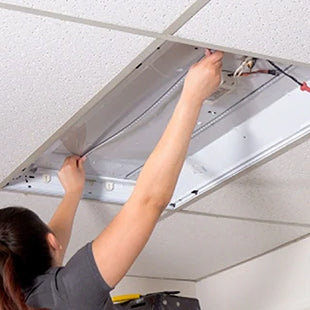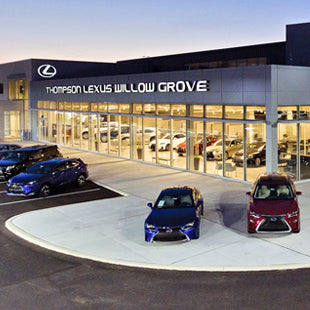LED High Bays Lighting Guide

How Many Watts, How Far Apart, and What Style Is Best for Your Application?
Outfitting a large, high-ceiling space with lighting isn’t the cheapest thing any of us will do this week. Let’s make sure that your next lighting investment hits the mark. No one wants to wind up spending more on lights—and subsequent operating costs—than they really need to, but many err in that direction in order to avoid under-lighting a space. Inadequate light makes it difficult and less safe for employees who have to work in it!
A little knowledge (and sometimes a quick call to our lighting pros) can move you into the sweet spot of just the right spread and intensity of light for your application.
What wattage LED high bays should I get?
We had all gotten used to wattage as an indicator of brightness. One 400W metal halide bulb was as bright as the next, right? Fluorescent lights threw us for the tiniest of curves when "High Output" versions were introduced, but even then—while a 54W HO light was more efficient than a standard fluorescent light, you could still depend on one 54W HO light outputting the same amount of light as any other 54W HO light.
Then came LED, a lighting technology where, under the forces of continual efficiency improvement, lower and lower wattages drive more and more light. This throws the old, dependable system of wattage = brightness out the window.
For instance, in 2014, the average LED high bay light could be expected to operate at a luminous efficacy of 83 lumens/Watt. If you were replacing a 400W metal halide light, you would have bought a 280W LED alternative, enjoyed a 30% reduction in your lighting costs, and come away thinking that a 280-Watt LED light was equivalent to a 400W metal halide.
Just five years later, you can now replace that 400W metal halide with a value-priced 200W LED high bay or a performance-oriented 150W high bay. That's a 50% and a 62.5% reduction in power consumption, respectively—and both wattages replace a 400 Watt metal halide. That right there shows how wattage is no longer very helpful as an indicator of brightness.
Let us introduce you to lumens. Lumens are the measure of visible light produced by a light source. All light sources, whether metal halide, fluorescent, incandescent, LED, etc., are measured in lumens. And, all other things being equal, a 24,000-lumen metal halide lamp puts out the same measure of visible light as a 24,000-lumen LED lamp or a 24,000-lumen fluorescent fixture.
So, now that we're talking lumens, we can narrow down what you need based on the height of your space's ceiling:
| Ceiling Height | Use a fixture rated |
| Over 40 feet | 40,000 lumens & up |
| 30 to 40 feet | 30,000 to 39,000 lumens |
| 20 to 30 feet | 20,000 to 29,000 lumens |
| 15 to 20 feet | 15,000 to 19,000 lumens |
Just where your application falls in that range depends on a few additional factors—for example, what your space is used for. Retail and manufacturing require brighter light at ground level than warehouse and recreation, for instance, and straight-up storage requires even less. Additionally, the size of your space and the color of your walls will affect your light choices.
And it's not just wattage and lumens—your voltage requirements may differ from the next guy's as well. At ELEDLights, many of our high bays are available in both 120V and 480V. If you don't see a 480V option listed for a product you're considering & 480V is what you need, give us a call.
Our lighting team has assisted with countless LED high bay lighting projects, from gymnasiums to warehouses, from equestrian arenas to airplane hangars, and much more. Call (215-355-7200), email (lights@eledlights.com), or hit up our Live Chat. With just a few questions we can tell you what lumens to look for in your new high bay LED lighting. Getting this right will save you from overspending on too much light or, worse, installing inadequate lighting you'll have to supplement later. Plus, we can assist you with motion sensors, lighting controllers, and other long-terms ways to save the most on energy—and energy costs.
How far apart should LED high bays be installed?
The closer together you install your fixtures, the more overlap the light at ground level will have—and the brighter that light will be. The farther apart you install your lights, the less overlap. Put them far enough apart and, instead of overlap, you'll have gaps. The bigger the gaps, the more uneven your lighting will be at ground level.
Therefore, you'll want at least some small degree of overlap. How much depends on how bright you need your lighting to be at ground level.
Additionally, your spacing will depend on your ceiling height. Light is cone-shaped. At the light source, it's concentrated. As it travels away from the source, it spreads outward. The farther from the source, the wider the spread. So, a light installed 15 feet off the ground has only 15 feet of travel before the light reaches the ground, making its circle smaller than that of a light installed at 30 feet, where it has twice the distance to travel—and spread—before reaching ground.
So, lights installed at only 15 feet high will need to be closer together to achieve overlap than lights that are installed at 30 feet. You can use this chart as a basic rule of thumb:
| Installation Height | Normal Brightness | High Brightness |
| Over 30 feet | 25 ft spacing | 20 ft spacing |
| 20 to 30 feet | 18 ft spacing | 16 ft spacing |
| 15 to 20 feet | 14 ft spacing | 12 ft spacing |
And, again, our lighting team has a lot of experience with high bay lighting. Call (215-355-7200), email (lights@eledlights.com), or hit up our Live Chat, and we'll not only be able to tell you how many fixtures at what lumens and at what spacing will give you the lighting you're looking for, we can even do up a lighting simulation for you, so you can be certain of what you're getting.
What type of LED high bays should I go with?

If you've poked around lighting sites, you'll have seen that LED high bay lights don't come in a single design. Learn more about the different styles and their purposes:
UFO LED High Bays
In the old days, you had metal halide for high bay lighting, and these lights required not only a lot of power but also a lot of warm-up time to get going. Because the bulbs themselves had a 360˚ beam angle, a lot of the light shone up into the fixture rather than down where you needed it. To combat this, metal halide fixtures had reflectors added.
LED lights don't need that. Because of the directionality of LED lighting, the full amount of light is directed where it's actually used. And, with no reflector, the shape of these HID replacements has earned them the name "UFO high bays."
Metal halide lamps also run extremely hot, and they burn out after 20,000 hours (15,000 for higher-wattage lamps)—but before burning out, they dim—quite significantly. You could expect to lose 50% of your light output halfway through the bulb's rated operating life.
Today's UFO high bays, relying on LED technology, are able to outperform metal halide in every aspect. Half the operating cost, twice the operating life, all the brightness, and after 50,000 hours, they'll still be putting out at least 70% of their original rated lumens.
We have a wide selection of UFO LED high bays to meet any ceiling height and application requirement.
Choose LED UFO high bays if:

- You're replacing metal halide fixtures and want to keep the same layout
- Your space is a large, open area, as a factory floor, gymnasium, airport, etc.
- Your ceilings are over 35 feet
- You need protection against dust, moisture, or water (round high bays are generally IP65 rated)
Linear LED High Bays
In the past, linear high bays have been fluorescent T5HO lights, for ceilings over 20 feet, and T8 or T12 for ceilings under 20 feet. T5HO technology was intended to be the high-efficiency alternative to metal halide high bay lights, and many properties were switched over to these lights, but they never quite lived up to their promise as a metal halide replacement.
As an alternative to linear fluorescent high bays, LED linear high bays actually do provide light as eye-popping as metal halide lamps while running at significantly less power (significantly less even than T5HO lamps) and lasting years longer without maintenance. Take a look at our linear LED high bay lights, suitable for both open areas and aisle lighting.
Choose linear high bays if:

- You're replacing linear fluorescent fixtures and want to keep the same layout
- Your space has aisles, assembly areas, or other specific rectangular footprints you want to follow
Specialty High Bays

Warehouses, big box stores, storage facilities, and retailers with high ceilings and tall vertical shelves should consider purpose-designed high bay warehouse aisle lighting. These fixtures are built for 60˚ x 100˚ (medium) or 25˚ x 85˚ (narrow) light distribution, specifically to illuminate shelves and aisle floors without wasting light to the tops of shelves. Does this sound like your application? Check out our warehouse LED lights.

Food, pharma, horticulture, car wash, and industrial laundry applications need water-shedding, easy-washdown high bay lighting. LED technology can be perfectly adapted to wet locations and can also receive NSF certification for use in food and pharmaceutical processing and a number of other industries. If this is what your application calls for, shop our washdown & NSF-certified LED high bays.
Still have questions?
Let us help you with your high bay lighting plan. Contact our lighting team with your type of application, ceiling height, space dimensions, wall color, and any questions you have.





